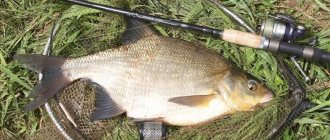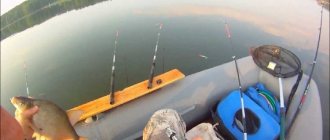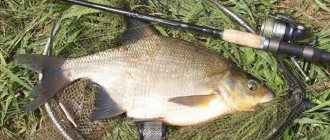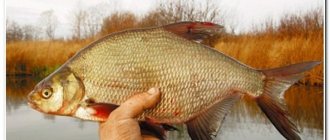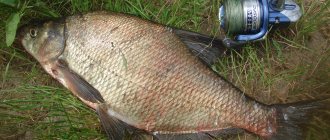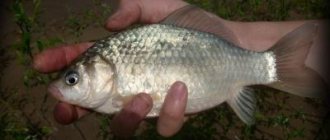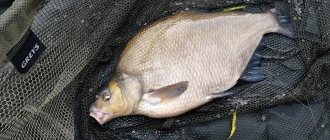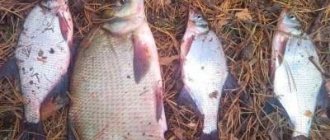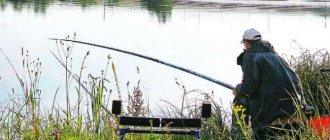Choosing feeder gear
There are no secondary elements for a feeder - each of them, from the rod to the feeder and the hook, plays its own important role in the success of bream fishing. The correct selection of each component and their harmonious combination allows you to obtain optimal and reliable equipment.
Rod length
Rods used for feeder fishing are divided into 3 groups according to their length:
- Picker - the shortest feeder rods, 2.4-3.0 meters long;
- Medium rods – 3.3-3.9 meters long;
- Long rods – 4.2-4.5 meters;
A feeder rod from one of the groups described above for bream fishing is selected taking into account the casting distance, the presence and speed of the current:
- When fishing on small flowing lakes, bays and old lakes with standing water or weak currents, as well as at a short distance (up to 20 meters) to the place where you plan to cast the equipment, use a picker up to 3 meters long.
- On medium and small rivers and lakes, medium-length rods (3.6-3.9 meters) are used.
- On large rivers with noticeable currents and reservoirs, where fishing is carried out from a fairly large distance from the shore, the longest (up to 4.5 meters) and durable forms are used.
The “golden mean” and the best option for beginner feeders among all sizes are 3.6-3.9 meter rods - such rods will allow you to fish both on the river and on a large lake and reservoir, make long and accurate casts with them, and perform effective hooks and catching fish from long distances.
Rod build
When fishing for bream on a feeder, rods with fast and medium-fast action are used - they allow you to make long and, most importantly, accurate casts, thanks to the rigid blank, they perform hooking better than rods with a slow action, and also land fish through dense thickets of aquatic vegetation.
The test of feeder rods is selected depending on the depth, the presence and speed of the current, the weight of the feeders with bait used in them, and the casting distance:
- For standing reservoirs, feeder picker rods with a test weight of up to 40-50 grams are used;
- When fishing on rivers and lakes with weak and medium currents, use forms with dough from 60 to 90-100 grams;
- On large reservoirs and large rivers, feeders with the largest dough of up to 150 grams or more are used;
Lure
Feeding a fishing spot can significantly affect the final result of the entire fishing trip. When catching bream on a feeder, you should take into account the following feeding features:
- It is advisable to start feeding fish a few hours before the start of fishing.
- It is better to prepare two bait mixtures - with a small and a large fraction. First, fine ground bait is used. It breaks up well and quickly spreads through the water column, luring fish.
- After several casts of bait with a fine fraction, you should add a feeder with a coarse mixture, especially if there was a bite. The bream will not be able to get enough of small particles and will quickly leave the point, but large parts will be able to hold it in place.
- Small and large fractions can be alternated during the fishing process, and also mixed in the feeder when casting.
Delivery of bait to the fishing point can be carried out in the following ways:
- hand at a short distance from the shore;
- slingshot with a casting range of up to 60 meters;
- bait feeder when casting 60 meters or more from the shore.
Adviсe:
- If the bite is weak, it is better to use an unsaturated bait mixture so as not to overfeed the fish.
- During the feeding season, with intense bites, you need to use only bait with a large fraction.
- To cast the bait feeder, you can use any other rod in order to preserve the quality of the feeder.
Feeder coil selection
An inertia-free reel for catching bream using feeder tackle should be:
- Reliable - all elements of the transmission mechanism and the housing must be made of durable and light alloy;
- With rear finely adjustable clutch;
- Gear ratio from 4.8 to 5.1;
- The number of bearings must be at least 3, with at least one each installed in the line roller and the handle;
- Size according to Shimano classification from 2500 for pickers to 4000-6000 for heavy and long rods with dough over 120 grams;
- It is advisable that the reel spool be shallow - this will allow the fishing line or cord to move freely from it when casting, which increases its range;
- A baitrunner is not necessary - bream, unlike carp, very rarely tears the rod off the stand.
Among the reel models that are most popular among feeders, the following should be noted:
- Ryobi ECUSIMA 3000;
- Shimano Catana 2500 FC;
- Daiwa Regal 4000XIA;
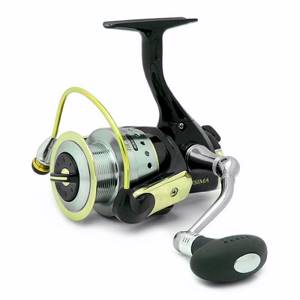
Ryobi Ecusima 3000
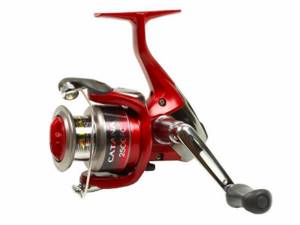
Shimano catana 2500 FC

daiwa-regal-4000
Feeder rod equipment
Choosing a fishing line for bream
In feeder fishing for bream, both monofilament and braided fishing lines are used, each of which has a number of recommendations for use in certain conditions:
- When feeder fishing at distances of up to 25-30 meters, it is best to use monofilament with a cross-section of 0.2-0.25 mm. With such a casting distance, it ensures good transmission of the bite to the tip of the rod; The stretchability of the monofilament absorbs the jerks of the fish.
- To make long feeder casts, braided fishing line with a cross-section of 0.12 to 0.18 mm is used. – unlike monofilament fishing line, braided line is stiffer, does not stretch and transmits bites better from a long distance. In a feeder equipped with braided fishing line, in order to eliminate the main disadvantage of this type of fishing line - its inextensibility, and, accordingly, the lack of shock absorption of fish jerks - the equipment (shock leader) is mounted on a piece of monofilament 3 to 5-6 meters long tied to the end of the braid. .
Selection of hooks
Hooks are selected depending on the attachments used:
- Bloodworms - small hooks made of thin and strong wire with a long shank No. 16-14;
- Maggot – hooks No. 10-14;
- Worm - hooks for fishing with this bait, as well as for bloodworms, should have a long shank and size No. 6-10;
- For vegetable baits (corn, peas, barley), hooks No. 8-12 are better suited;
Among manufacturers, the best quality hooks used for feeders are from the following brands:
- Gamakatsu – LS-5314N, LS-1010B,LS-1040R;
- Owner – series 50922, 53157, 50152;
- Kamasan –B532;
Feeder for bream
When fishing for bream on a feeder, the most common are mesh metal and plastic feeders of open and semi-closed types.
Open feeders on the end sides do not have plugs, due to which the bait spills freely to the bottom after casting - they are used in reservoirs where there is no current.
Semi-closed type feeders have a plastic cap at the bottom at one of the ends, which prevents the bait from freely pouring out of the feeder - they are used on rivers and flowing lakes with currents of varying speeds.
In addition, when choosing a feeder feeder, it is worth considering that this element of the gear must be resistant to drift by the current - rectangular or square-shaped feeders with a weight located on the rear wall are best able to resist the movement of water.
The choice of feeder weight depends on the casting distance and current speed:
- If the range is short and there is no current, the lightest feeder feeders weighing up to 40 grams are used;
- On rivers and flowing reservoirs with medium flow, feeders weighing from 60 to 90-100 grams are used;
- For very long casts, as well as on rivers with strong currents, the heaviest feeders weighing from 100-120 to 150 grams are used.
Hooks and leader material
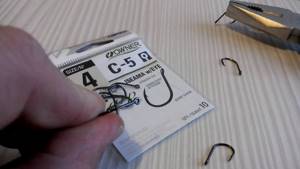
Thick wire hooks are suitable for catching large fish. But you shouldn’t put small bait on such a hook, it will quickly become unusable.
We recommend reading: The best lures for perch in winter
As for hooks, hooks from number ten to number two according to the European classification are used for catching bream. The choice of hook size depends on the expected size of future prey and bait.
As for the shape of the hook for catching bream on a feeder, it is better to use hooks that have a sting offset from the axis of the forearm. When hooking, the force goes along the fore-end, but the sting looking to the side clings to the inside of the bream’s lips, after which the hook seems to rotate somewhat, firmly digging into the mouth of the prey.
Hooks in the shape of a question mark perform well when fishing on a feeder. But in the case of such fishing, the size of the bait must correspond to the size of the hook. Because otherwise, empty hooking may occur.
It is convenient to use hooks with a short shank and a tip bent inward. This hook will perform well when fishing for prey. If the fish is hooked, it is unlikely to escape. But when hooking, such a hook shows itself worse than its analogues. However, there is one trick here. When fishing with such hooks, you should take a significant pause before hooking. This is done so that the bream swallows the bait deeper.
As for the thickness of the wire, you can choose fairly thick hooks. Although you shouldn’t abuse the wire diameter either. Hooks made of thin wire are chosen in cases where fishing is carried out with bloodworms. Because this delicate bait quickly dies on thick hooks and loses its attractive appearance.
Baits and lures
Animal origin
Among the baits used for feeder fishing for bream are the following:
- Bloodworm;
- Maggot;
- Muckworm;
- Shell meat.
Vegetable origin
Of the vegetable baits widely used in feeder fishing, the following are used:
- Canned corn;
- Steamed peas;
- Pea mastyrka;
- Pearl barley;
When the bite is weak, they often make a combination bait, of which the combination most often gives results:
- 2-3 maggots + bloodworms;
- 1 large grain of corn + 2-3 maggots;
- 1 large corn grain + dung worm;
Bait
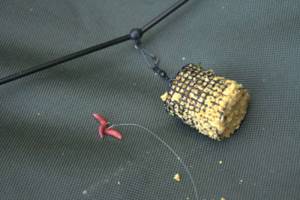
A neat bunch of several moving maggots is a tasty dish for bream.
To catch bream, the most common baits used are maggots, bloodworms and worms. The dung worm is considered the most suitable for this fish among all types of worm. It has a sharp, unique odor, which apparently attracts bream. I recommend putting several halves of medium-sized dung worms on the hook. Such a tangle is sure to seduce both a small bream and a scoring bream.
Maggots are also put on several pieces per hook. You need to pierce the larvae from the edge, carefully, with a sharp hook. Then they will remain alive for a long time and attract fish with their movement.
Bloodworms should also be put on several pieces at a time in order to partially cut off the small fish. A sandwich made from bloodworms with maggots or maggots with a worm shows good results.
This list of live baits can be supplemented with other larvae, but they are less popular. But if we are talking about baits of natural origin, then it is better to focus on corn, peas, ordinary bread, pieces of undercooked potatoes and other similar delicacies.
Recommended reading: Fishing for grayling in winter
Bait for bream
Complementary feeding plays a huge role when catching bream on a feeder. It attracts fish to the fishing point and keeps it there for a long time. Therefore, the choice of bait mixture based on color, consistency and composition should be treated very responsibly.
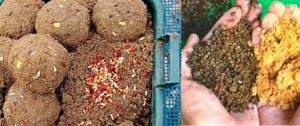
Color
In terms of color for catching bream with this bottom tackle, the most catchy ones for the entire open water season are red mixtures.
Consistency
The density of the prepared bait must correspond to the fishing conditions - on the lake and for feeding they make a looser mixture, but when fishing on the current, in order to prevent the bait from being washed away by water flows, a more viscous or even dense consistency is very quickly used
Smell
When preparing bait with your own hands, to make it more attractive, special additives are added - flavorings, which give the mixture a certain smell. Flavoring bait is more effective in warm water, so in spring and early autumn additives are used in smaller quantities than in summer. Among the smells, bream prefers the aromas of vanilla, anise, coriander, ground coffee, and molasses.
Store-bought bait
Among the purchased fertilizers, the following brands are most popular:
- Sensas 3000 Feeder;
- RS Sport Feeder;
- Dunaev Bream.
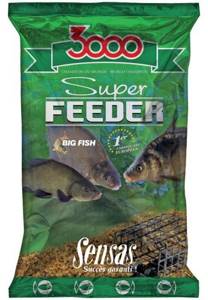
3000 super feeder, bream
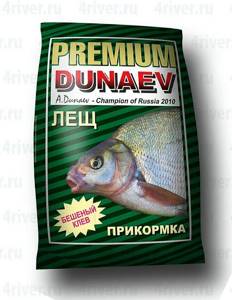
Dunaev Premium bream
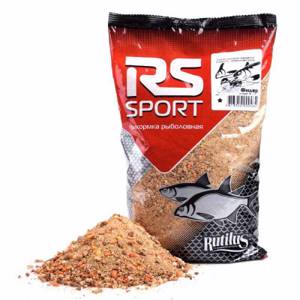
RS Sport bream
Homemade
The following homemade recipes for homemade feeder baits are the most catchy and at the same time easy to make:
For fishing in the current
- makukha (sunflower cake) – 200 grams;
- breadcrumbs – 100 grams;
- pre-sprouted peas – 200 grams;
- oatmeal – 200 grams;
- ground coriander - 3 teaspoons;
- red clay;
For fishing in still water
- breadcrumbs – 300 grams
- well-roasted and ground sunflower seeds – 200 grams
- rye bran – 300 grams;
- millet porridge – 300 grams;
- ground coriander – 2/3 teaspoon;
- red clay.
In bait mixtures used in autumn and summer, in addition to plant components, chopped worms, small food bloodworms, and maggots are added in large quantities
Recipe for preparing bait for catching bream on a feeder:
- breadcrumbs – 400 g;
- wheat – 400 g;
- corn grits – 300 g;
- Hercules flakes - 200 g;
- powdered milk – 100 g;
- roasted sunflower seeds – 100 g;
- vanilla sugar – 50 g;
- flax – 50 g;
- beets or food coloring.
Wheat grains are fried for 10-15 minutes until golden brown. Hercules flakes and flax seeds are fried until brown. Next, everything is crushed and mixed with breadcrumbs and corn flour. The mixture is thoroughly mixed, then milk, vanilla, flavoring and coloring are added (when using beets as a natural coloring, just grate them and mix them with the main mixture). This bait is well balanced in color and smell, can be stored for up to 6 months, and meets all the taste preferences of bream. Before you start fishing, you need to knead it with water to the desired consistency and let it brew. You should also add bait components.
Adviсe:
- Bream often travel in schools, so a small amount of bait will not be able to keep the fish in one place.
- Some fishermen note that the basis of the bait should be bait. In this case, the maggot must first be scalded with boiling water.
- The mixture should be viscous so as not to disintegrate in the water before the feeder reaches the bottom. The stronger the current in the pond, the thicker and more viscous the consistency of the bait.
- It is advisable to soak the bait for catching bream on a feeder 8-10 hours before the start of fishing, so that all components are thoroughly swollen and mixed.
- The soil from the bottom of the reservoir acts as a good binding element and helps make the smell and color of the bait more natural.
Choosing a fishing spot
Bream is a bottom-living fish. Inhabits large and medium-sized rivers, reservoirs, large and medium-sized flowing lakes. In reservoirs it prefers the deepest places, holes and pools with a silty, clayey bottom rich in food. In rivers, it most often lives in deep channel ditches on quiet reaches, near steep banks, and sunken snags. Bream go to shallow waters to feed during the warm season at night, leaving them at dawn.
Bream does not like places with fast currents and a rocky or pebble bottom, therefore fishing for bream on fast rivers is unlikely to bring you a catch.
Fishing with a feeder in still water
In reservoirs without a current, bream are caught with short feeders (up to 3 meters) and medium-length rods (3.3-3.6 meters) using open-type feeders weighing up to 40 grams.
When fishing in large reservoirs and lakes, longer rods (4.2 -4.5 meters) and heavy feeders weighing up to 90 grams are used.
The bait used is quite loose, and the feeding process itself should ensure the accuracy of the feeding casts.
The main feeder installations are a paternoster (for reservoirs with a cluttered bottom), a symmetrical loop
Basic attachments
- In summer - grains of canned corn, steamed peas, pearl barley, a bunch of bloodworms and maggots.
- In spring and autumn - bloodworms, maggots, dung worms.
Fishing on the current
When catching bream on a feeder in the current, rods with large dough and semi-closed mesh feeders weighing up to 100-120 grams are used. The length of the blank is selected taking into account the fishing distance - for casting at a distance of up to 40 meters, 3.6-3.9 meter rods are used; if it is necessary to deliver equipment to a longer distance, long-range ones are used

Migration of bream on the edges
When preparing the bait, make it more viscous, avoiding the presence of floating ingredients in it.
The baits and attachments used are the same as when fishing in still water.
Catching bream on a feeder at night
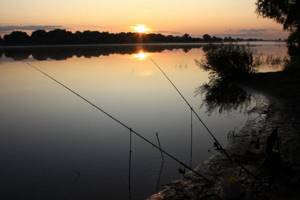
Night fishing for bream is most effective when the early summer heat gains strength and the bream feeds more actively in the dark.
Schools of bream feed on warm nights with rapidly passing drizzling rains near channel dumps, on underwater tables - flat hills surrounded on all sides by significant depths.
For feeder fishing, as a rule, more powerful and durable rods with a length of no more than 4 meters and a test weight of over 100 grams are used - the safety margin is explained by the fact that at night there is a high probability of bites from large breams that can break a light rod.
Feeding of the chosen place is carried out during daylight hours, and in the evening a landmark is chosen for casting to the fishing point, clearly visible in the dark against the background of the night sky. When fishing in still water with a feeder, a discarded pre-marker float with a luminous tip is often used as a guide.
Larger baits are used on the feeder at night than during the day - the bream is actively looking for food and takes it more confidently at this time. A bunch of dung worms, large grains of canned corn, and, less often, maggots and bloodworms are used as bait.
To signal a bite, a special attachment – a “firefly” – is attached to the tip. The use of bells and other sound alarms is not justified - when biting, the fisherman will not be able to instantly determine in the dark which of several tackles the fish took.
To check and re-throw gear, be sure to take with you a powerful LED flashlight with a battery or spare batteries.
Techniques and features of fishing with a feeder
The feeder fishing technique includes the following techniques:
- Measuring the depth, relief and nature of the bottom using a marker sinker;
- Selection based on measurements of the most promising areas of the reservoir;
- Feeding the fishing point using special, larger feeders;
- Casting the baited tackle some time after feeding;
- By winding the coil, the signaling tip is bent;
- When biting, a sweeping, sharp hook is performed;
- Fishing for hooked fish.
When fishing with a feeder, the accuracy of casting the equipment in the same place every time after landing a fish or when checking and refilling the feeder is very important. This is achieved by clipping the line and choosing a clearly visible and immovable landmark on the opposite bank for casting.
Fishing technique
Fishing for hooked bream is carried out first at a fast pace in order to remove the fish from the fishing point to prevent scaring away the bream gathered near the bait spot, and then at a slower pace.
When pulling the bream to the shore, they work with a rod and a reel, picking up the slack that forms. After the bream has appeared on the surface, it is brought into the bucket of a landing net with a long handle and carefully brought to the shore without removing it from the water.
Frequent breakages of the tips occur when large bream are pulled too hastily onto the shore or bridge without using a landing net.
Popular feeder accessories
You can mount a lot of equipment on bream with your own hands. Most popular:
- Equipped with an anti-twist tube. This bream feeder rig is suitable for beginners. It is a thin curved plastic tube from 5 to 25 cm long. It is very easy to install this equipment.
We stretch the fishing line through the anti-twist tube. We put a stopper on the line on the long side of the tube. This could be a bead or a rubber bumper. Next, at the end of the fishing line we knit a loop for the leash. The loop is knitted with a regular figure eight knot. I don’t think there’s any need to explain how to knit a figure eight. If you tie a knot on braid, you need to make at least 3 turns, since braid slips, unlike monofilament fishing line. That's all, the equipment is ready. The main disadvantage of this equipment is the low sensitivity of the equipment.
- Paternoster or Gardner's loop. According to many fishermen, this is the best equipment for feeder fishing. It has good sensitivity and is also very easy to make.
At the end of the fishing line we knit a loop for the leash. Next, measure 20 cm of fishing line from the beginning of the loop and fold this piece in half. We knit another figure eight. That's it, the paternoster is ready.
- Symmetrical loop. Good for catching large fish. Since this equipment is sliding, the fish often catches itself when biting. It is knitted as follows.
We measure 30 cm of fishing line and fold it in half. At the end of the segment we make a loop for the leash. Next, you need to twist the two ends of the fishing line. The twist will not allow the leash to overlap when casting. To do this, twist the ends of the fishing line in opposite directions. The twist length should be 10-15 centimeters. Next, we knit a figure eight knot at the end of the twist. We put a swivel on the short end of the fishing line and tie a 10 cm loop. We have a symmetrical loop.
- Asymmetrical loop. Knits exactly the same as a symmetrical loop, but with one exception. Having made the twist and put on the swivel, you need to pull it back 1-2 centimeters and only then tie the loop.
- Helicopter and 2 knots. Good equipment for fishing in the current. Correct installation looks like this:
We measure 30 centimeters from the end of the fishing line. Bend the line in half. We retreat 10 centimeters from the top of the loop and knit a figure eight knot. We drag the swivel into the loop and throw it on top. We tighten it. Next, we retreat 2 centimeters from the top knot and knit a figure eight knot. We attach a feeder to the long loop, and a leash with a hook to the short loop.
Fishing at different times of the year
Spring
March
In spring fishing, most reservoirs still have a fairly thick ice cover, and active ice drift has not yet begun on the rivers. Bream is caught in March using winter gear - a float rod, a jig.
April
After the ice melts, the bream leaves the wintering pits and, as the water warms up, moves closer to the shore to places with a depth of 2-3 to 5 meters, bordering the pits and pools. The fish begin to bite towards the middle to end of the month.
The main bait at this time is a dung worm, bloodworms, maggots and a combination of them.
In the process of preparing bait, chopped worms, small bloodworms, and maggots are added to it along with plant components.
Flavorings - vanilla, cinnamon - are added to the bait in small quantities.
When fishing in reservoirs without a current, pickers are used, while in rivers, rods up to 3.6 meters long are used. When fishing with a pickerel, a classic bottom rig is often used, in which a lead sinker is used instead of a feeder.
May
At the beginning of this month, bream go to spawn in flooded floodplain meadows, reeds, and shallow waters surrounded on all sides by depths. Mature individuals lay their eggs on grass and reed stems. Spawning continues until the mid-early third decade of May. After spawning, bream in schools roll into deep holes, where after some time they are caught on a feeder.
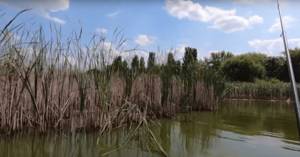
For river fishing, long feeder rods are used; in reservoirs with standing water or weak currents, picker rods are more convenient.
After spawning, the bream, along with bait, begins to take well on vegetable baits - corn, pearl barley, peas.
Summer
June
In June, before the onset of summer heat, bream are successfully caught in holes and pools at depths from 4-5 to 8-12 meters with mandatory feeding of the chosen place. The gear used is the same as at the end of spring. In the evening and morning, bream emerges from the holes into the adjacent irrigation areas and shallows overgrown with grass and reeds.
Among the baits preferred at this time are corn, peas, as well as sandwiches - “bloodworm-maggot”, “corn-worm”, “corn-maggot”.
Bream bite best in the morning and at dawn.
July August
In the midst of the summer heat, night fishing for bream on a feeder is the most productive. When fishing this way, it is necessary to pre-feed the fishing spots. Rods are used taking into account not only the casting distance, the weight of the feeder, but also the presence of bushes, trees, high banks and other obstacles that in the dark can damage the form upon impact.
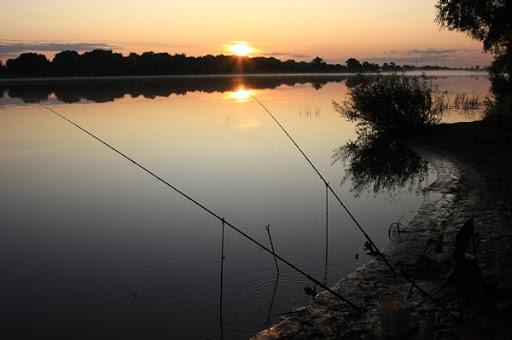
Be sure to use a large amount of bait. A bunch of large worms and corn grains are used as bait.
Luminous attachments on the tip of the rod are used as a bite indicator.
The most active bite is observed from 8-9 pm to 2-3 am.
